How to make a clothes dryer with your own hands - a master's approach
Content:
Saving money is an important task for almost every family. It is better to invest an extra penny on a trip with outdoor activities than in a device that is not too difficult to make on your own. In fact, a clothes dryer is a necessary item in our everyday life.
A roomy factory dryer will cost about 10,000 rubles, and a smaller product will not allow you to hang more than two tabs of linen, which is extremely inconvenient in a working, especially a large family. A little zeal and a couple of free evenings - and you will find yourself the owner of a roomy dryer. Well, let's get down to business!
Basic principles of the device
The following types of dryers are available:
- ceiling - this is a conventional drying device, consisting of cords, strings, tubes or rods stretched close to the ceiling, hung on brackets fixed to the ceiling;
- wall - a model that is mounted to one or two opposite walls, equipped with a folding or sliding mechanism; in full width and length is straightened only if necessary; another option is the brackets on the walls, but above the level of the head of an adult, such a dryer can be stationary;
- floor - portable construction, installed in any convenient place of the apartment, folding compactly after use;
- combined (wall-ceiling) is a dryer that is fixed to the ceiling brackets and a fixing bracket placed on the wall; This is a very functional device, as it lowers and rises like blinds for the convenience of hanging clothes.
Specifications for clothes dryer:
- the material should not succumb to rust or somehow dirty the things;
- the minimum weight maintained by the structure should be 30–35 kg (a voluminous basin filled with wet clothes or 2 wet carpets);
- the capacity of the structure should correspond to the weight, fastenings and crossbars, that is, when filling the dryer with things, it should not collapse under their weight;
- fasteners of a suspended structure should be simple and reliable, minimally affecting the finish and building elements;
- the mobile dryer in assembled form should weigh no more than 12 kg, just be folded out and firmly fixed in working condition;
- ideally, when it is possible to freely hang large linen, and not to spread it, that is, the cross-pieces (cord or bar) in the working position should be placed as far as possible from the floor or soil;
- purityis.decorexpro.com/en/ experts recommend that the height of the structure in the working position be made so that it is possible to hang up and also remove clothes without standing on a stool or stand - this will protect you from possible injuries;
- it is preferable that the things are kept on a dryer without clothespins;
- it is desirable that the portable dryer can fit in the bowl of the bathtub, providing a drain of water from things that are not recommended to be wrung out after washing.
What dryers are made of
Clothes dryers are made mainly from plastic and metal. Let us dwell on the advantages and disadvantages of products made from the most common materials.
Plastic hangers are the cheapest option. They are lightweight and easy to transport and assemble. The disadvantage of plastic models is their lack of strength, their service life is usually short.
Stainless steel options are the most expensive, but they are unrivaled in reliability. Stainless steel - a strong material - deformation of the dryer under the weight of the linen is excluded. Do not need enameling or chrome plating, as they are not afraid of oxidation and moisture (rust), do not leave marks on clothes.
Chrome devices, as well as enameled ones, are basically iron. As long as the coating is intact, they are resistant to moisture and do not stain laundry. More sensitive to mechanical damage and less durable than stainless steel dryers, however, with careful handling for decades.
Aluminum structures are lightweight and reliable, but also have their drawbacks. The bottom line is that aluminum is not suitable for rooms with high humidity. Constantly in contact with wet linen, it undergoes oxidation, which leads to clothes indelible spots. Therefore, most often, aluminum structures are coated with enamel. Another drawback is relative softness. This design is quite easily deformed under the weight of the laundry.
Ropes are the most common material for homemade dryers. Previously, thick cotton samples were used, today they have been replaced by reliable synthetic analogues that are less stretchable, resistant to abrasion, easy to clean (just wipe with a cloth soaked in water), and are available in a wide range of colors. Most preferable for a clothes dryer are plastic rather thick ropes with a metal core inside. They do not sag and have a very long life. The minus of such cables is that they will not be tied to a knot enough (due to the high elasticity, this is difficult to do).
Do it yourself
With your own hands, you can make a clothes dryer, which is placed on the floor, suspended from the ceiling, on a central heating battery, on a wall, as well as a street one installed outside the window. Consider the most convenient options.
Interesting fact! A great many original constructive ideas are known: clothes dryers confidently lead among designs in the number of patents issued for them.
Rope dryer
A drawback of conventional rope constructions is that under the weight of raw laundry, the cords stretch and sag. Periodically, the rope has to be pulled harder, which subsequently leads to damage, and a new cord is required. To solve the problem, you can replace traditional ropes with a string, a metallized cord or thick fishing line.
We recommend that you build a more reliable option, similar to a traditional rope dryer, which is able to withstand heavy laundry.
The following materials will be required:
- pieces of stainless steel pipe with a diameter of 2-3 cm - 2 pcs.;
- wooden block 6-8 cm thick - 4 pcs.;
- metal spring - 4 pcs. (as much as possible, based on the width of the intended dryer);
- metallized cord - 10-15 m.
Procedure:
- Wooden blocks will serve as brackets for our device. In the center of each bar, it is necessary to drill recesses whose diameter is equal to the cross section of the metal pipe. Fasten the bars at both ends of the pipes. Drill the transverse holes through which the linen cord will be threaded along the length of the pipes at equal intervals of 10-15 cm.
- Fix the bars together with the pipes horizontally on the walls opposite each other. Below the pipe about 50 cm in the wall, drill holes located exactly opposite the holes on the pipe. Insert self-tapping screws into the wall holes. Tie the springs on them with a cord. From the spring, lay the cord in the hole on the pipe and lead it to the opposite wall. Pass the cord through the hole in the other pipe and tie it to the corresponding spring. Perform this sequence for the remaining springs.
- Springs on the wall are best masked with decorative panels.
Folding dryer
It is mounted to the wall, but is not stationary.When not needed, such drying develops along the wall and does not take up space. The design is used as a room.
Materials required:
- a plank of wood to form a frame;
- wooden rods;
- square plywood or drywall for the base;
- a pair of furniture hinges;
- simplest folding device;
- furniture handles or wall hooks;
- fasteners;
- acrylic paint.
The rods should be the same length.
Procedure:
- Drill holes on the inside of two opposing frame members. The diameter of the holes is equal to the cross section of the rods. Insert the rods into the holes. For convenience of fixing in the holes, it is allowed to thin the rods at the ends.
- Assemble the frame, fixing the parts together with nails.
- Now we need to prepare the base, which is 10-15 cm longer than the frame in length and width. Attach the lower strip of the frame to the base with furniture hinges.
- Paint the structure, let it dry completely.
- Install a locking latch on the opposite side of the hinges, and a folding device on the left and right sides. It is necessary to correctly select the maximum angle for the folding mechanism, then in the opened form, the drying will not block the passage.
- To fix hooks on the lower edge of the base of the dryer or on the side of the frame for hanging small items of clothing.
- Drill a hole in the wall, install the dryer.
An interesting design move is to paint the rods in a different shade or color, alternating one through one or two through two. Choose a tone that will be in harmony with the decor of the room.
Simple stationary dryer
This is the easiest drying option, making which is not difficult. Externally, the design looks like in the photo.
You will need:
- wooden block 0.6-0.8 m long - 2 pcs.;
- varnish for wooden surfaces (furniture possible), brush;
- metallic underwear cord;
- self-tapping screw - 4 pcs.;
- dowel - 4 pcs.;
- hook or self-tapping screw with a loop - 1 pc.;
- roller block - 1 pc. (optional);
- pencil for marking;
- drill and punch.
Procedure:
- Drill six symmetrical holes for the clothesline and two more holes for fastening in the bars. Perform hole cleaning, varnish the bars.
- When the coating dries, pull the cord through the holes. Do not pull the cord into the last hole.
- Punch the marked holes in the wall ahead of time with a punch.
- Fix the dryer to the wall. Screw a self-tapping screw with a loop or hook into the last right hole of the left bar. This is necessary to fix the rope.
- Pull the linen cord, tie it on the hook.
- The design is mounted above head level.
To facilitate the hanging process and raise the laundry higher, an additional bar, roller block and hook are used. With their help, a simple lifting device is constructed:
- The cord is threaded into the bar with the desired number of holes (this bar should be placed approximately in the center of the structure when the extreme support bars are fixed on the walls. The cords are pulled so that after fixing they hang very much - it’s more convenient to hang. And the bars are attached to the very ceiling.
- A roller block is attached to the ceiling near the center of the structure.
- A cord is thrown from the strap through the block (it is convenient to tie a metal ring at the end).
- Then, using the tension of the lifting cord, the ropes are pulled to the ceiling - measure at what level the end of the lifting cord turned out to be. At this point, attach the hook on which the ring of the lifting cord will be worn to fix the lift in the upper position.
When choosing a location on a loggia or balcony, note that the design should not impede the opening of doors and windows.
Wall-mounted swing dryer
Another version of the lifting structure. This time, not cords are used, but rods or rods. A rigid frame is assembled, painted in a suitable color.One end (it can be either the short or the long side of the frame - it all depends on the room where the installation is carried out) is attached to the wall on furniture or other hinges so that when folded the frame hangs along the wall, not occupying space.
On the same wall, above the dryer, a roller block and a hook for fixing the cord are attached. To the second, lower, when viewed in folded) end, the cord is attached and throws on the block. When pulling the cord, the edge of the frame rises, the design takes a horizontal position. You can hang on an inclined or lowered frame.
Ceiling Dryer Swing
Here, an accurate calculation of the length of the lifting cords will be required so that the frame is located strictly horizontally. Two roller blocks are attached to the ceiling. Through them, the ends of the lifting cords passed along the side bars of the frame are thrown.
Above the center of the structure, the cords are connected and braided into a cable or harness and passed between the rails. The tension of the cable swing rises to the ceiling, the end of the cable is fixed on a wall hook or just to the leg of the bedside table in the corridor.
We considered only the basic devices on the basis of which you can create exclusive instances. The result depends on what materials are available on the farm. If you like to create with your hands, then it will be easy for you to make a clothes dryer.
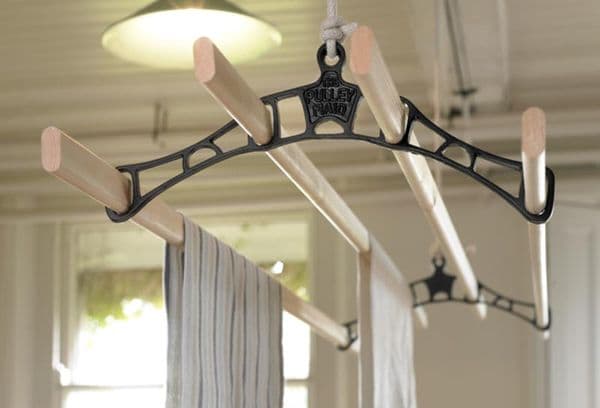
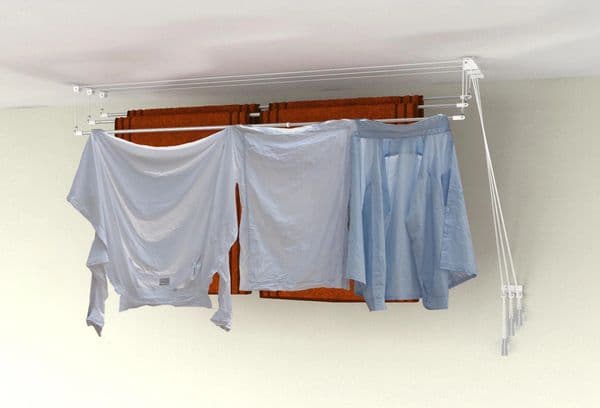
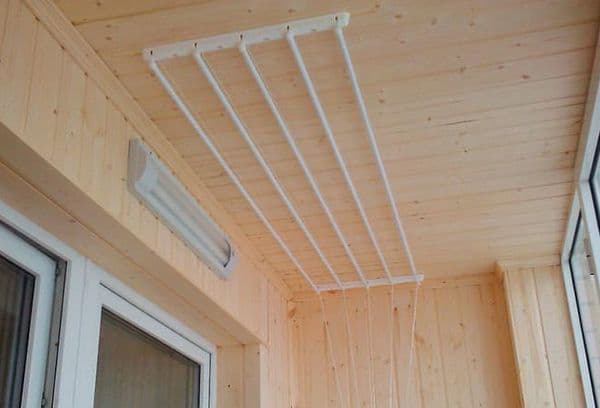
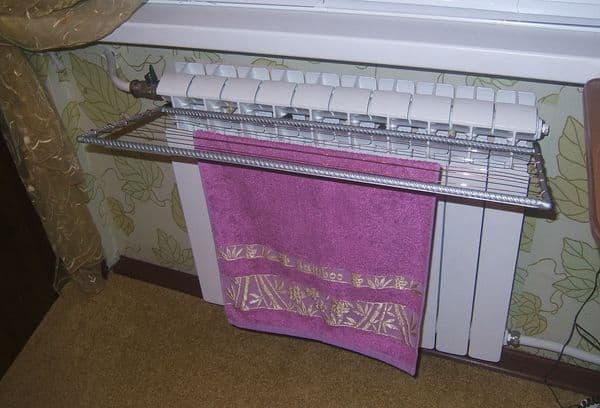
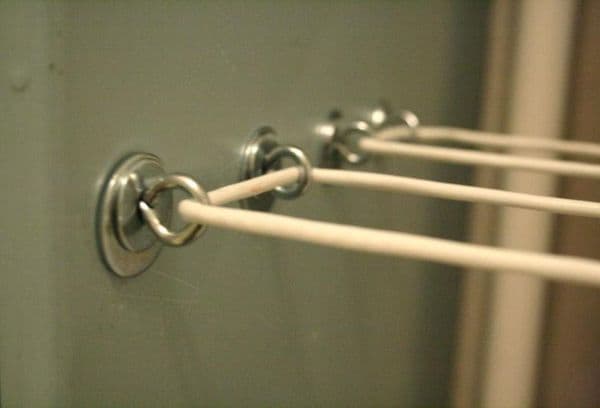
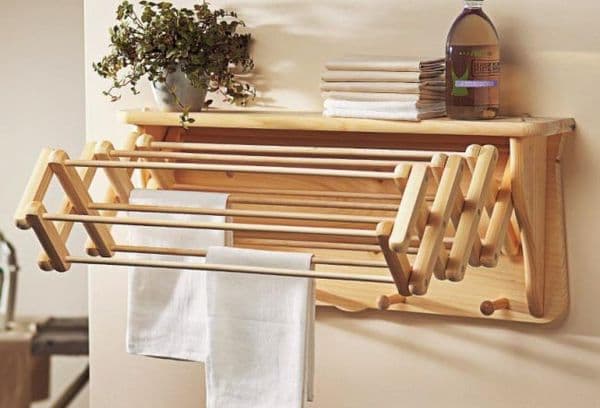
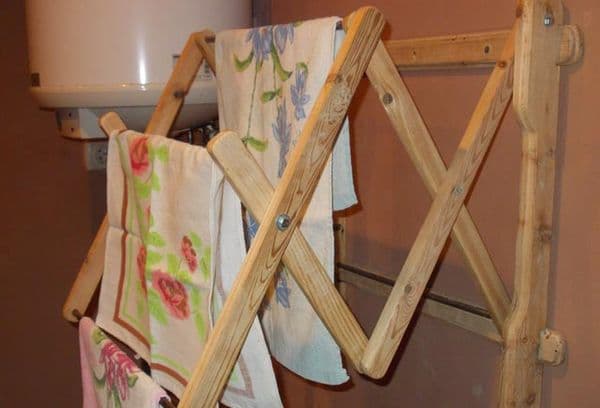
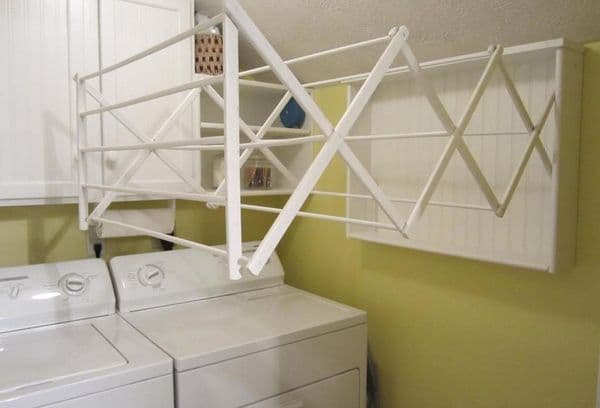
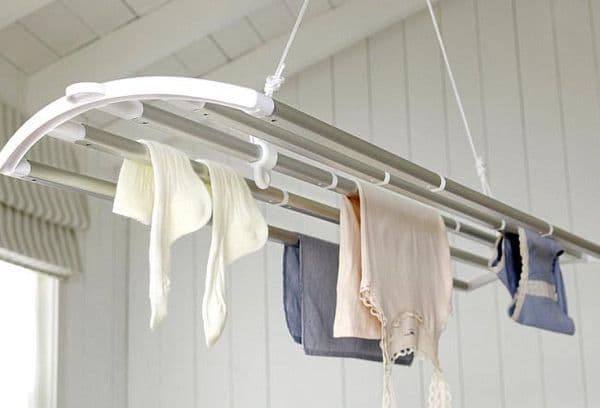
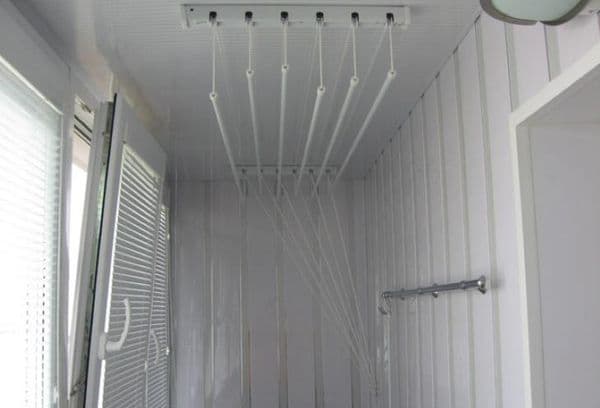
the second floor hangs the sheets, closes my window. where do I apply?